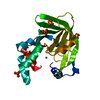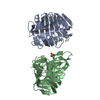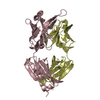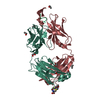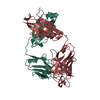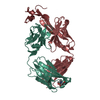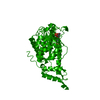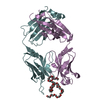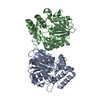[English] 日本語
 Yorodumi
Yorodumi- SASDA35: SeZinT-SeZnuA complex (High-affinity zinc transporter periplasmic... -
+ Open data
Open data
- Basic information
Basic information
| Entry | Database: SASBDB / ID: SASDA35 |
|---|---|
 Sample Sample | SeZinT-SeZnuA complex
|
| Function / homology | : / :  Function and homology information Function and homology information |
| Biological species |  Salmonella enterica subsp. enterica serovar Nchanga (bacteria) Salmonella enterica subsp. enterica serovar Nchanga (bacteria) Salmonella enterica subsp. enterica serovar Enteritidis (bacteria) Salmonella enterica subsp. enterica serovar Enteritidis (bacteria) |
 Citation Citation |  Journal: Biochim Biophys Acta / Year: 2014 Journal: Biochim Biophys Acta / Year: 2014Title: The Salmonella enterica ZinT structure, zinc affinity and interaction with the high-affinity uptake protein ZnuA provide insight into the management of periplasmic zinc. Authors: Andrea Ilari / Flaminia Alaleona / Giancarlo Tria / Patrizia Petrarca / Andrea Battistoni / Carlotta Zamparelli / Daniela Verzili / Mattia Falconi / Emilia Chiancone /  Abstract: BACKGROUND: In Gram-negative bacteria the ZnuABC transporter ensures adequate zinc import in Zn(II)-poor environments, like those encountered by pathogens within the infected host. Recently, the ...BACKGROUND: In Gram-negative bacteria the ZnuABC transporter ensures adequate zinc import in Zn(II)-poor environments, like those encountered by pathogens within the infected host. Recently, the metal-binding protein ZinT was suggested to operate as an accessory component of ZnuABC in periplasmic zinc recruitment. Since ZinT is known to form a ZinT-ZnuA complex in the presence of Zn(II) it was proposed to transfer Zn(II) to ZnuA. The present work was undertaken to test this claim. METHODS: ZinT and its structural relationship with ZnuA have been characterized by multiple biophysical techniques (X-ray crystallography, SAXS, analytical ultracentrifugation, fluorescence spectroscopy). RESULTS: The metal-free and metal-bound crystal structures of Salmonella enterica ZinT show one Zn(II) binding site and limited structural changes upon metal removal. Spectroscopic titrations with ...RESULTS: The metal-free and metal-bound crystal structures of Salmonella enterica ZinT show one Zn(II) binding site and limited structural changes upon metal removal. Spectroscopic titrations with Zn(II) yield a KD value of 22±2nM for ZinT, while those with ZnuA point to one high affinity (KD<20nM) and one low affinity Zn(II) binding site (KD in the micromolar range). Sedimentation velocity experiments established that Zn(II)-bound ZinT interacts with ZnuA, whereas apo-ZinT does not. The model of the ZinT-ZnuA complex derived from small angle X-ray scattering experiments points to a disposition that favors metal transfer as the metal binding cavities of the two proteins face each other. CONCLUSIONS: ZinT acts as a Zn(II)-buffering protein that delivers Zn(II) to ZnuA. GENERAL SIGNIFICANCE: Knowledge of the ZinT-ZnuA relationship is crucial for understanding bacterial Zn(II) uptake. |
 Contact author Contact author |
|
- Structure visualization
Structure visualization
| Structure viewer | Molecule:  Molmil Molmil Jmol/JSmol Jmol/JSmol |
|---|
- Downloads & links
Downloads & links
-Models
| Model #91 |  Type: mix / Radius of dummy atoms: 1.90 A / Chi-square value: 1.317904  Search similar-shape structures of this assembly by Omokage search (details) Search similar-shape structures of this assembly by Omokage search (details) |
|---|---|
| Model #92 |  Type: dummy / Radius of dummy atoms: 1.90 A  Search similar-shape structures of this assembly by Omokage search (details) Search similar-shape structures of this assembly by Omokage search (details) |
- Sample
Sample
 Sample Sample | Name: SeZinT-SeZnuA complex / Sample MW: 56.49 kDa / Specimen concentration: 0.17-5.00 / Entity id: 75 / 76 |
|---|---|
| Buffer | Name: 50 mM HEPES 50 mM KCl / Concentration: 50.00 mM / PK: 7 / pH: 7.5 / Comment: 4-(2-hydroxyethyl)-1-piperazineethanesulfonic acid / Composition: KCl 50.000 mM |
| Entity #75 | Name: ZinT / Type: protein Description: High-affinity zinc transporter periplasmic component Formula weight: 33.25 / Num. of mol.: 1 / Source: Salmonella enterica subsp. enterica serovar Nchanga / References: UniProt: V2JZU2 Sequence: FAALSAALWG SATQAADAAV VASLKPLGFI ASAIADGVTD TQVLLPDGAS EHDYSLRPSD VKRLQGADLV VWVGPEMEAF MEKSVRNIPD NKQVTIAQLA DVKPLLMKGA DDDEDEHAHT GADEEKGDVH HHHGEYNMHL WLSPEIARAT AVAIHEKLVE LMPQSRAKLD ...Sequence: FAALSAALWG SATQAADAAV VASLKPLGFI ASAIADGVTD TQVLLPDGAS EHDYSLRPSD VKRLQGADLV VWVGPEMEAF MEKSVRNIPD NKQVTIAQLA DVKPLLMKGA DDDEDEHAHT GADEEKGDVH HHHGEYNMHL WLSPEIARAT AVAIHEKLVE LMPQSRAKLD ANLKDFEAQL AATDKQVGNE LAPLKGKGYF VFHDAYGYYE KHYGLTPLGH FTVNPEIQPG AQRLHEIRTQ LVEQKATCVF AEPQFRPAVV EAVARGTSVR MGTLDPLGTN IKLGKTSYSA FLSQLANQYA SCLKGD |
| Entity #76 | Name: SeZnuA / Type: protein / Description: Zinc/cadmium-binding protein / Formula weight: 23.24 / Num. of mol.: 1 Source: Salmonella enterica subsp. enterica serovar Enteritidis References: UniProt: L6R5I5 Sequence: MLLVNSPAFA HGHHAHGAPM TEVEQKAAAG VFDDANVRDR ALTDWDGMWQ SVYPYLVSGE LDPVFRQKAK KDPEKTFEDI KAYYRKGYVT NVETIGIENG VIEFHRDNNV ASCKYNYAGY KILTYASGKK GVRYLFECKD ANSKAPKYVQ FSDHIIAPRK SAHFHIFMGN ...Sequence: MLLVNSPAFA HGHHAHGAPM TEVEQKAAAG VFDDANVRDR ALTDWDGMWQ SVYPYLVSGE LDPVFRQKAK KDPEKTFEDI KAYYRKGYVT NVETIGIENG VIEFHRDNNV ASCKYNYAGY KILTYASGKK GVRYLFECKD ANSKAPKYVQ FSDHIIAPRK SAHFHIFMGN TSQQALLQEM ENWPTYYPYQ LKANEVVDEM LHH |
-Experimental information
| Beam | Instrument name: ESRF BM29 / City: Grenoble / 国: France  / Type of source: X-ray synchrotron / Wavelength: 0.93 Å / Dist. spec. to detc.: 2.43 mm / Type of source: X-ray synchrotron / Wavelength: 0.93 Å / Dist. spec. to detc.: 2.43 mm | |||||||||||||||||||||||||||
|---|---|---|---|---|---|---|---|---|---|---|---|---|---|---|---|---|---|---|---|---|---|---|---|---|---|---|---|---|
| Detector | Name: Pilatus 1M | |||||||||||||||||||||||||||
| Scan |
| |||||||||||||||||||||||||||
| Distance distribution function P(R) |
| |||||||||||||||||||||||||||
| Result |
|
 Movie
Movie Controller
Controller

 SASDA35
SASDA35

